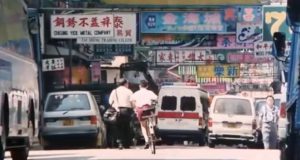Little Cheung
Hou Jianing(3036268139)&Wang Qinghui(3036265242)





The film Little Cheung is directed by Fruit Chan in 1999 as the threequel of the Hong Kong Trilogy. The story talked about a 9-year-old boy called Little Cheung and happened in 1997, the occasion of Hong Kong’s return to China. The director uses the innocent perspective of a child to relay the thoughts of adults, the connection between people, and the process of the handover between the old and new eras in Hong Kong. Through the changing times, more and more buildings have been demolished and rebuilt due to the ravages of time, and this movie is in a way a record of the society and space of that time.
Portland Street serves as the backbone of the entire movie, presenting the life of the community like a stage. Neon signs has been in Hong Kong since its birth in the 1920s. As Hong Kong’s economy development, shops of all sizes followed suit, and neon signs blossomed on the streets of Hong Kong, competing for attention. By the 1990s, neon signs had become one of the representative symbols of Hong Kong’s world-famous culture. Eileen Chang (1943) once wrote in Love in a Fallen City when the protagonist saw neon lights in Hong Kong:
It was a hot afternoon, and the most striking thing to look at was the giant billboards lined up on the pier, red, orange, pink, reflecting in the green water, a line, a dash of irritating offending pigment, scurrying up and down, fighting under the water in an exceptionally lively manner.
Neon signs is the symbol of Hong Kong’s night scene, and the colorful signs carry craftsmanship and aesthetics, as well as the historical and cultural imprint of Hong Kong’s times.
Starting from 2014, tens of thousands of neon signboards in Hong Kong have begun to disappear from Hong Kong’s downtown area as a result of the Signboard Verification Scheme (SGS) launched by the Buildings Department (BD) of the Hong Kong Special Administrative Region Government (HKSARG).
Regarding the question of why neon signs are gradually disappearing, first of all, some neon signs have weathered for decades and are so old that they need to be renovated and repaired. These old neon signs not only affect the appearance of the city but may also pose safety hazards. The removal of these old signs is to ensure the safety of the city and to eliminate potential safety hazards. In addition, some neon signs may have non-compliance problems, being used without permission or not in accordance with the regulations. These non-compliant neon signboards not only violate the town planning and management regulations but may also damage the image and order of the city. Removal of these non-compliant signboards can enhance the management of urban image and planning and maintain good urban order. From the change of technology in the 1990s to the Hong Kong Government’s Safe Disposal of Outdoor Signboards Programme, the number of neon signboards on the streets of Hong Kong has been reduced by 90% compared to its heyday in the 1990s. According to the information in the papers of the Yau Tsim Mong District Council of Hong Kong, from 2015 to 2018, 803 neon signboards were removed in Yau Tsim Mong district. The rise, fall and demise of neon signs seem to bear witness to the changing times of the city.
However, for many members of the public and businesses, these neon signs are not only a tool for their business promotion, but also their memories and emotional attachment to Hong Kong. Each neon signboard represents a story and a piece of memory. Therefore, while removing these signboards, the Hong Kong Government also needs to consider how to find a balance between urban renewal and historical memory. To address this issue, the Hong Kong Government has launched the “Historical Signboard Restoration Programme”. The programme aims to preserve and restore neon signboards of historical value, while encouraging businesses to use modern and environmentally friendly promotional methods. In this way, the Hong Kong Government can maintain urban safety and good order while preserving the memories and sentiments of the public and businessmen about Hong Kong.
Not only neon signs, but also many historical buildings or structures have not been adequately preserved because of previous neglect. Meanwhile, because that area is gradually falling behind and the economy is in the doldrums, many stores have withdrawn on their own as a result. How Hong Kong’s local culture will be preserved is a question that will soon be faced in the next decade.